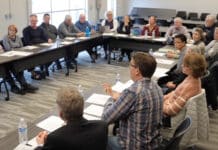“It is only in understanding the past and these values that we can once again renew our republic” (“Restoring Our Republic” by Ned Ryun).
“Restoring Our Republic” by Ned Ryun, founder and CEO of American Majority and Voter Gravity and former Presidential Writer for George W. Bush, informs readers on how the republic of America came to be, from the ancient Hebrews to the Founding Fathers of our country. Ryun examines the truths and beliefs this nation was built upon, and he suggests active ways to maintain and advocate for those Constitution-inspiring principles today.
The subtitle of “Restoring Our Republic” reads “The Making of the Republic and How We Reclaim It Before It’s Too Late.” To me, this insinuates that about half of the book will cover the history of America’s Republic, and the other half will cover the means by which citizens can “reclaim” that republic today. However, I found that “Restoring Our Republic” was not evenly broken up in this way at all. About 90% of the book involves the direct retelling of America’s founding, while only the last two chapters address practical ways to keep ahold of the Constitutional values that cultivated America. After reading the back cover and various blurbs printed in the front matter, I definitely anticipated more “how-to” and less of a history lesson.
However, while this book was not exactly what I expected, I do think it gives a solid and clear explanation of what values America was built on and where those values came from. Ryun focuses heavily on the fact that Christian beliefs profoundly shaped the documents that establish America’s legal independence and government. The Founding Fathers looked to the Bible as their guidebook: They knew Scripture and natural law given by God had to “form the basis for all just human laws” (Ryun). As a Christian myself, I appreciate the attention Ryun gave to acknowledging the importance of God’s word to most, if not all, of those who founded our nation.
I found this book to be an excellent overview of America’s journey to independence and democracy, but I would not say it gives any sort of in-depth explanation on any specific topic. Rather, it reads like a high school-level text on American history. In some chapters, I found myself wishing the author would use specific examples—to help explain, let’s say, how the branches of government make and enforce laws, instead of taking 50 pages to hypothetically tell how it’s done.
The last two chapters, though, made the book worthwhile for me. Ryun gives practical ways to “reclaim” the republic, from getting involved in local government, to putting the Golden Rule into true practice, voting, and remembering the moral and Christian beliefs about human nature and government.
If you’re looking for a nonfiction, easy-to-follow, patriotic book that is a reminder of America’s roots in freedom, “Restoring Our Republic” is right up your alley. But if you’re looking for something more in-depth on how to reinstate the Founding Fathers’ Christian values and morals in our government today, I would suggest a close reading of Chapters 16 and 17, and perhaps a Google search or two.
If you have ideas for book or movie reviews I should write, email me at ebfr@nycunarjfza.pbz.

















